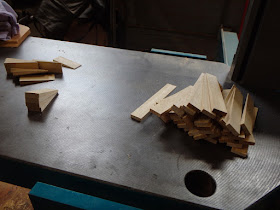A stray pic from last time, showing the use of a chisel to clean up a trimmed through tenon:
Another stray - a look at one of the leg assemblies after the lower stretcher tenon has been wedged, prior to trimming:
The wedges are in avodire, in an attempt to make the through tenons, which are numerous, a less overt design element. The wedge stock is prepared from flat-sawn stock, then the wedges are cut out on the sliding chop saw:
The medium bench after the two leg sets have been fitted:
And a little further along, the two smaller benches are nearing completion:
Then came the larger bench, the assembly of which i decided to video tape - the editing and publication of the video that followed is the primary reason why the 8th post in this thread was slow to eventuate.
Here's a video I put together showing the assembly of the long bench:
There were some additional pics which didn't make it into the video, for various reasons. I had intended to show more of the finish planing, however on that day my camera's video card became full just as I got into some of the planing, and a video of planing which I thought I had taken ended up only being a 5 second recording of nothing. I did manage to snap a couple of pics from one of the shorter benches however:
Here's one where you can see the portion of end grain and wedge within the wider shaving, which I think looks kinda neat:
I find avodire very pleasant to work in general, save for the dust, which if I breathe in any significant amount, say while cross-cutting on the table saw, I find my lung capacity becomes a bit diminished for 24 hours. Like a short term asthmatic reaction. Maybe some people would have a worse reaction to this wood, so if you tend to have reactions to wood dust (which I don't, knock on wood), then caution would be in order with this species. I've found simply paying attention to having the dust collection going even when doing minor tasks seems to take care of the issue.
A final step, not shown in the video as the hardware arrived on the scene only in the past couple of days, was the fitting of some decorative nails, or tacks (termed byō in Japanese). I put these in because they are somewhat common on the Japanese benches that I have come across. I decided however not to use these tacks in any way as an actual fastener, but purely for their decorative effect alone. The tacks I obtained are only as long as the boards are thick, so they perform no mechanical attachment function.
Here you can see a bunch fitted to the mid-size bench:
I think fitting nails to board in such a fashion, if they were to actually go all the way through and fasten into the supporting crosspiece below, is not the best idea given that the bench seat boards will tend to widen and narrow with seasonal moisture swings. Now, in this case, the bench seat boards are vertical grain material, and the bench is an indoor item in a conditioned space, however I stick to the principal of designing around wood movement all the same.
The budget for this project did not allow for more elaborate all-wood joinery solutions, so I instead fastened the middle of each board to the supporting crosspieces with a trim-head screw, as you can see in the above picture. Of course, in no way did I want these screw heads to be visible, so I came up with a way to cover them with the decorative head tacks, which were only a bit larger in diameter than the screw heads.
I cut a notch in the side of the screw head using a thin cut off wheel with my portable 4.5" disc grinder:
Another view:
As you can see, these are Torx head trim screws. My thought was that this form of drive would exert at most only modest forces into the screw head (trying to split it), and thus, even with the head slitted like that, the screw head would be tough enough to withstand re-insertion in the hole, and such proved to be the case:
Then the tack can thereby be driven nearly straight over top of the screw:
The result is a concealed screw head which, if need be, could be accessed again in the future:
I found this approach worked really well, and only had a couple of tacks out of the total which didn't work out on the initial try and had to be replaced.
The mid-size bench complete, with all the tacks in place:
The small bench was the quickest to nail:
The avodire has some nice figure and chatoyance which my pics do not do justice.
And nailing the long bench took a while:
That's all for this round. Look for a follow-up post in the near future, and thanks for visiting the Carpentry Way. Post 9 rolls around next.

















No comments:
Post a Comment
All comments are moderated. Spamming and comments containing links unrelated to blog content will be deleted.